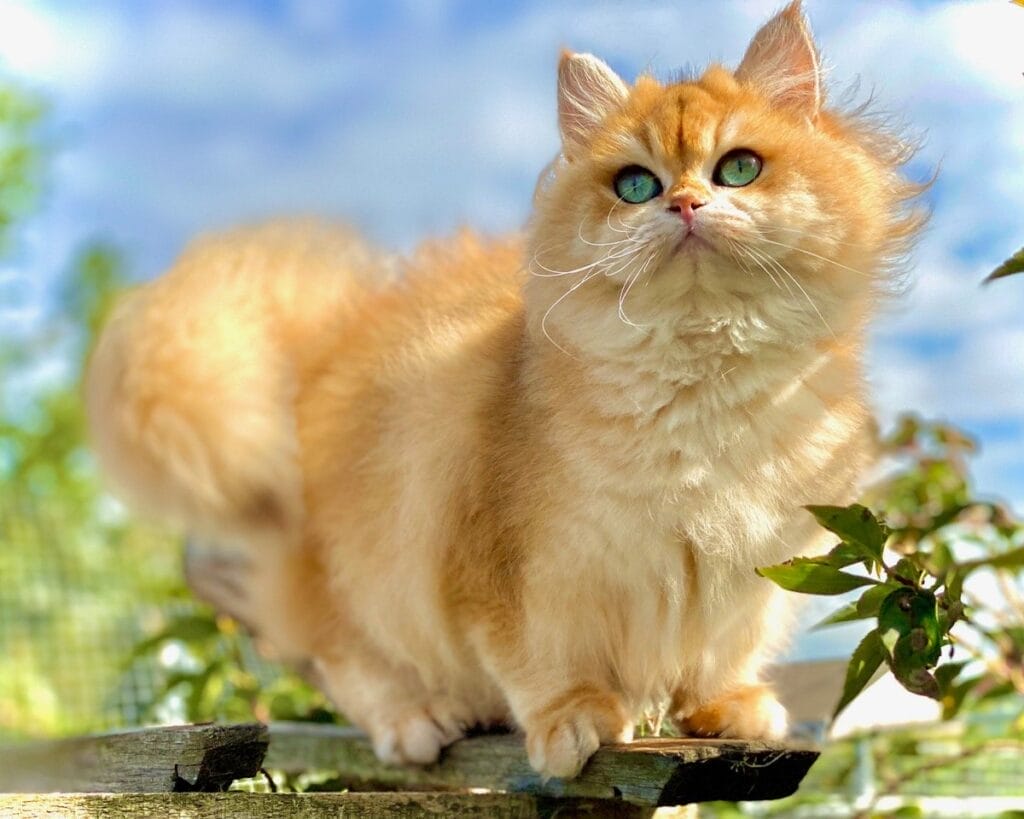The British Longhair shares ancestry with the British Shorthair but has a semi-longhaired coat inherited from crossing with longhaired cats like Persians and Himalayans. They have a similar sturdy body type and calm temperament as British Shorthairs but with a glamorous, high-maintenance coat.
Introduction The British Longhair Cat Breed
The British Longhair has a medium to large, muscular body with relatively short limbs. Their coat length varies from semi-long to long. The plush, dense fur resists matting and water. British Longhairs weigh 8-20 lbs as adults. Coat colors include blue, black, white, red, cream, brown, chocolate, lilac, and silver. This breed has round, expressive eyes and medium-sized ears.

Affectionate with Family: ⭐⭐⭐⭐⭐
Amount of Shedding: ⭐⭐⭐
General Health: ⭐⭐⭐⭐
Potential for Playfulness: ⭐⭐⭐
Tendency to Vocalize: ⭐⭐
Kid-Friendly: ⭐⭐⭐⭐⭐
Friendly Toward Strangers: ⭐⭐⭐
Easy to Groom: ⭐⭐
Intelligence: ⭐⭐⭐
Pet Friendly: ⭐⭐⭐⭐
- Appearance: Sturdy, muscular body and short legs. Medium to long, plush, silky coat. Round head and expressive eyes.
- Characteristics: Affectionate, gentle, easygoing, enjoys human interaction. Moderate energy levels.
- Popularity: Gaining popularity but still somewhat uncommon outside Britain.
- Temperament: Devoted, calm, sweet-natured. Excellent pets for families. Gentle with children.
- Lifespan: 9-15 years.
- Coat Color: Blue, black, white, red, cream, chocolate, lilac, silver. Pointed patterns exist too.
- Origins: The British Longhair combines British Shorthair and longhaired breeds like Persians.
Caring for a British Longhair Cat Breed
Food:
- High-quality dry and wet cat food. Ensure adequate protein and fat content.
- Feed a measured amount based on weight, age, activity level. Avoid overfeeding.
- Provide constant access to clean, fresh water. Consider a cat fountain.
Environment:
- Safe, comfortable home environment free of major stresses. Give them access to sunny spots.
- Cat trees, scratching posts, beds placed in social areas so they don’t feel isolated.
- Regularly clean litter boxes. Try different litters to see which they prefer.
Grooming:
- Brush coat thoroughly at least twice a week to prevent matting. Trim around the paws.
- Bathe occasionally when needed using cat-safe shampoo. Dry coat thoroughly.
- Check and wipe eyes and ears weekly for discharge. Trim nails every 2-3 weeks.
- Start grooming routines early and keep them relaxed and rewarding.

Take Care Method: Engage their natural hunting drive through interactive playtime. Use puzzle feeders and treat balls for mental stimulation. Spend bonding time petting and brushing them.
Adopting/Buying a British Longhair
- Popularity Locations: Most breeders are in the UK. Also found in parts of North America and Scandinavia.
- Average Price: $800 – $1200 USD. Show cats can cost $2000+
- Adoption/Rescue: Check shelters and breed-specific rescues. Be wary of “free to a good home” ads.
What to Check Before Adopting:
- Overall health and body condition. Active, alert, no signs of neglect/abuse.
- Up to date on all vaccines and vet care. Review medical records.
- Confirm pedigree if relevant. Ensure not from unethical kitten mills.
Preparing for a British Longhair
- Cat-proof your home. Secure chemicals, toxic plants, and delicate objects.
- Have supplies ready – food, litter, grooming tools, scratching posts, safe toys.
- Find a trusted vet and schedule a first visit for exams, establishing care.
- Give them time to adjust to their new home before introducing to other pets.
- Provide daily playtime and affection. Monitor their appetite and litter habits.
Equipment:
- Sturdy cat tree, scratching posts
- Slicker brush, comb, nail clippers, toothbrush
- Interactive wand toys, treat puzzles
- Ceramic food bowls, water fountain
Common Diseases:
- Hypertrophic cardiomyopathy
- Polycystic kidney disease
- Respiratory infections

Important Vaccines:
- Feline viral rhinotracheitis
- Calicivirus, panleukopenia
- Rabies
Naming Your British Longhair
Choose a friendly, dignified name that complements their noble bearing. Consider British-inspired names, food names, or classic human names. Some examples: Winston, Wellington, Victoria, Missy, Biscuit, Marmalade, Oliver.
Do British Longhairs like going outside rather than staying indoors?
Cats tend to prefer being indoor cats. Provide supervised outdoor access using a leash and harness if desired.
Are British Longhairs smart cats?
Yes, cats are quite intelligent and can learn tricks or walk on a leash with training.
How many types of British Longhair cats are there?
There are no separate breeds. Color variations include blue, black, white, red, cream, chocolate, lilac, silver, tabby, tortoiseshell, bicolor.
How to stop a British Longhair from biting?
Redirect biting onto appropriate toys. Say “no” firmly and ignore them after biting. Reward gentle play. Consider deterrent sprays.
How to stop a British Longhair from scratching?
Provide ample scratching posts. Praise them for using scratchers. Use nail caps or double-sided tape on furniture. Trim nails regularly.
How to socialize and raise a friendly British Longhair?
Gently handle them often from a young age. Reward calm, friendly behavior with treats and play. Introduce new people/sights positively.
How to train a British Longhair?
Use reward-based methods like clicker training. Practice basic commands. Use target sticks. Keep sessions short and positive.
How often should British Longhairs see the vet?
Annual vet exams are recommended. Senior cats over 10 years old should visit the vet twice yearly.
Are British Longhairs good family pets?
Yes, they tend to be extremely affectionate and gentle with kids and family when socialized early on.
Are British Longhairs good with children?
Yes, their laidback personalities make them very patient with gentle children. Always supervise young kids with pets.
Are British Longhairs good with other pets?
Generally yes, though high prey drives may require monitoring around small pets like rabbits. Proper introductions are key.
Can British Longhairs cause allergies?
Moderate to high. Their long coat produces more dander. Bathing and brushing helps reduce allergens.
Are British Longhairs ferocious?
No, British Longhairs are incredibly mellow, gentle cats. They may playfully swat but are not prone to aggression.
Do British Longhairs have hair loss problems?
Shedding is normal with season changes. Significant hair loss can signal an underlying medical issue needing veterinary attention.
Are you a cat lover who wants to learn more about your furry friends? Do you want to find the best cat food, cat care tips, and resources for your cats? If so, you’ve come to the right place! Welcome to Cat Food Site, the ultimate website for cat enthusiast.
Here you will find everything you need to know about cats Breed, from their health and behavior to their breeds, cat diet and names. You will also discover the latest cat news, cat nutrition, trends, and memes from around the web.

